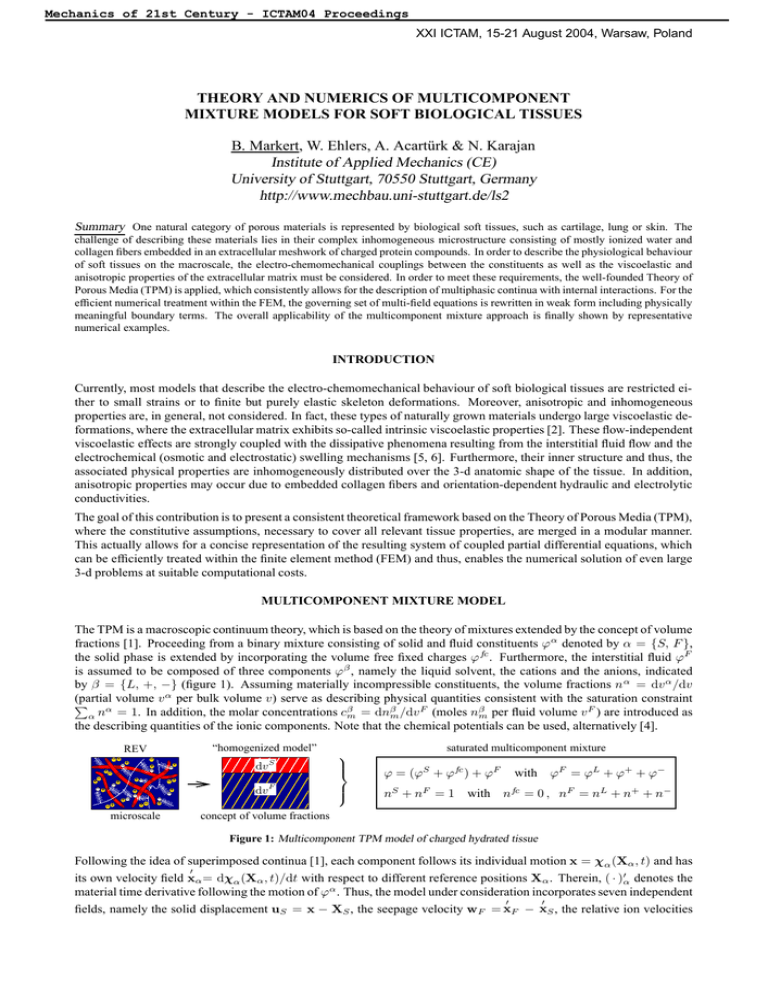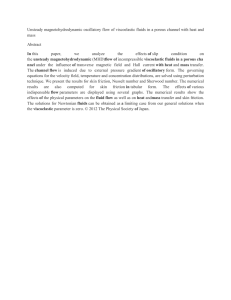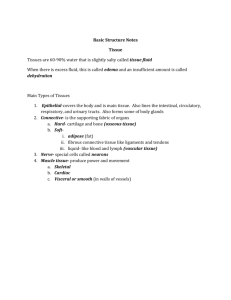Institute of Applied Mechanics (CE) University of Stuttgart, 70550 Stuttgart, Germany -stuttgart.de/ls2
advertisement

Mechanics of 21st Century - ICTAM04 Proceedings
XXI ICTAM, 15-21 August 2004, Warsaw, Poland
THEORY AND NUMERICS OF MULTICOMPONENT
MIXTURE MODELS FOR SOFT BIOLOGICAL TISSUES
B. Markert, W. Ehlers, A. Acartürk & N. Karajan
Institute of Applied Mechanics (CE)
University of Stuttgart, 70550 Stuttgart, Germany
http://www.mechbau.uni-stuttgart.de/ls2
Summary One natural category of porous materials is represented by biological soft tissues, such as cartilage, lung or skin. The
challenge of describing these materials lies in their complex inhomogeneous microstructure consisting of mostly ionized water and
collagen fibers embedded in an extracellular meshwork of charged protein compounds. In order to describe the physiological behaviour
of soft tissues on the macroscale, the electro-chemomechanical couplings between the constituents as well as the viscoelastic and
anisotropic properties of the extracellular matrix must be considered. In order to meet these requirements, the well-founded Theory of
Porous Media (TPM) is applied, which consistently allows for the description of multiphasic continua with internal interactions. For the
efficient numerical treatment within the FEM, the governing set of multi-field equations is rewritten in weak form including physically
meaningful boundary terms. The overall applicability of the multicomponent mixture approach is finally shown by representative
numerical examples.
INTRODUCTION
Currently, most models that describe the electro-chemomechanical behaviour of soft biological tissues are restricted either to small strains or to finite but purely elastic skeleton deformations. Moreover, anisotropic and inhomogeneous
properties are, in general, not considered. In fact, these types of naturally grown materials undergo large viscoelastic deformations, where the extracellular matrix exhibits so-called intrinsic viscoelastic properties [2]. These flow-independent
viscoelastic effects are strongly coupled with the dissipative phenomena resulting from the interstitial fluid flow and the
electrochemical (osmotic and electrostatic) swelling mechanisms [5, 6]. Furthermore, their inner structure and thus, the
associated physical properties are inhomogeneously distributed over the 3-d anatomic shape of the tissue. In addition,
anisotropic properties may occur due to embedded collagen fibers and orientation-dependent hydraulic and electrolytic
conductivities.
The goal of this contribution is to present a consistent theoretical framework based on the Theory of Porous Media (TPM),
where the constitutive assumptions, necessary to cover all relevant tissue properties, are merged in a modular manner.
This actually allows for a concise representation of the resulting system of coupled partial differential equations, which
can be efficiently treated within the finite element method (FEM) and thus, enables the numerical solution of even large
3-d problems at suitable computational costs.
MULTICOMPONENT MIXTURE MODEL
The TPM is a macroscopic continuum theory, which is based on the theory of mixtures extended by the concept of volume
fractions [1]. Proceeding from a binary mixture consisting of solid and fluid constituents ϕ α denoted by α = {S, F },
the solid phase is extended by incorporating the volume free fixed charges ϕ fc . Furthermore, the interstitial fluid ϕF
is assumed to be composed of three components ϕβ , namely the liquid solvent, the cations and the anions, indicated
by β = {L, +, −} (figure 1). Assuming materially incompressible constituents, the volume fractions n α = dv α /dv
α
(partial
physical quantities consistent with the saturation constraint
P α volume v per bulk volume v) serve as describing
β
β
F
β
F
α n = 1. In addition, the molar concentrations c m = dnm /dv (moles nm per fluid volume v ) are introduced as
the describing quantities of the ionic components. Note that the chemical potentials can be used, alternatively [4].
PSfrag replacements
REV
−
−+ +
−
+
−+
−
+−
+−
+−
−+
+
−
−+
+
+
−
−
−
+−
− +
+
+
−
microscale
“homogenized model”
dv
S
dv F
concept of volume fractions
saturated multicomponent mixture
ϕ = (ϕS + ϕfc ) + ϕF
with ϕF = ϕL + ϕ+ + ϕ−
nS + nF = 1 with nfc = 0 , nF = nL + n+ + n−
Figure 1: Multicomponent TPM model of charged hydrated tissue
Following the idea of superimposed continua [1], each component follows its individual motion x = χ α (Xα , t) and has
0
its own velocity field xα = dχα (Xα , t)/dt with respect to different reference positions Xα . Therein, ( · )0α denotes the
material time derivative following the motion of ϕα . Thus, the model under consideration incorporates seven independent
0
0
fields, namely the solid displacement uS = x − XS , the seepage velocity wF = xF − xS , the relative ion velocities
Mechanics of 21st Century - ICTAM04 Proceedings
XXI ICTAM, 15-21 August 2004, Warsaw, Poland
0
0
wγ = xγ − xS , the effective interstitial fluid pressure p, and the molar ion concentrations c γm , where γ = +, − indicates
only the mobile ions. Note that the fixed charges are directly coupled to the solid displacement and thus, represent no
0
0
independent field. Moreover, for the liquid solvent, it is assumed that xL ≈ xF , i. e. wL ≈ wF .
GOVERNING EQUATIONS
For the numerical treatment within the FEM, weak forms of the governing multi-field equations are required. Therefore,
the seepage velocity and the cation diffusion are eliminated by use of the extended Darcy filter law and the extended
Nernst-Planck equation. Together with the electroneutrality condition, this yields a concise representation of the governing balance relations by means of the primary variables uS , p, and c+
m . Subsequently, weighted by independent test
functions and integrated over the spatial domain Ω with the surface ∂Ω, one finds the respective weak form of the mixture
volume (MV), the cation concentration (CC), and the mixture momentum (MM) balances:
Z
Z
Z
GMV ≡
δp div (uS )0S dv −
grad δp · nF wF dv +
δp q̄ da = 0 ,
Ω
Ω
∂Ω
Z
Z
Z
F + 0
+
F
+
0
dv
−
grad
δc
·
n
c
w
dv
+
δc+
n
(c
)
+
c
div
(u
)
GCC ≡ δc+
m
+
S
m
m ̄ da = 0 ,
m S
m
S
m
Ω
∂Ω
Ω
Z
Z
δuS · t̄ da = 0 .
grad δuS · (TSE mech. − p I ) dv −
GMM ≡
Ω
∂Ω
δc+
m
Therein, δuS , δp, and
are the corresponding test functions, q̄ denotes the efflux of the interstitial fluid over the
surface ∂Ω, ̄ is the anion diffusion over ∂Ω, and t̄ is the external load vector acting on the entire mixture. Moreover,
TSE mech. = TSEQ + TSNEQ + TSANISO represents the purely mechanical Cauchy extra stress tensor, which is constitutively
decomposed into isotropic elastic (equilibrium) and viscoelastic (non-equilibrium) parts T SEQ and TSNEQ , as well as an
anisotropic term TSANISO . Note that the hydraulic and osmotic stress contributions are completely included in the entire
fluid pressure p.
NUMERICAL EXAMPLES
The efficiency of the presented model is shown by two fully coupled 3-d simulations using the FE tool PANDAS. By
incorporating appropriate constitutive equations for the description of the osmotic and electrostatic phenomena [3], it is
possible to simulate free swelling behaviour. For the example depicted in the left hand side of figure 2, the external ion
concentration was lowered on the yellow surrounding surface to initiate swelling. Furthermore, the model can be applied
for the description of intervertebral disc (IVD) tissue, whenever the implemented constitutive law for T SANISO is suitable
for the macroscopic simulation of the collagen fiber-bundles within the anulus fibrosus. First physically sound results are
achieved on an idealized 3-d geometry of a motion segment of the lumbar spine subjected to an axial compressive load
yielding a finite deformation response of the IVD (figure 2 right).
PANDAS
with fibers
without fibers
Figure 2: Free swelling of a hydrogel block (left) and idealized model of the IVD with nucleus pulposus and anulus fibrosus (right)
References
[1] E HLERS , W.: Foundations of multiphasic and porous materials. In Ehlers, W. & Bluhm, J. (eds.): Porous Media:
Theory, Experiments and Numerical Applications, Springer-Verlag, Berlin, 2002, pp. 3–86.
[2] E HLERS , W. & M ARKERT, B.: A linear viscoelastic biphasic model for soft tissues based on the Theory of Porous
Media. ASME J. Biomech. Eng. 123 (2001), 418–424.
[3] E HLERS , W.; M ARKERT, B. & ACART ÜRK , A.: Large strain viscoelastic swelling of charged hydrated porous
media. In Auriault, J.-L. et al. (eds.): Poromechanics II, Balkema, Lisse, The Netherlands, 2002, pp. 185–191.
[4] H UYGHE , J. M. & JANSSEN , J. D.: Quadriphasic mechanics of swelling incompressible porous media. Int. J. Engng
Sci. 35 (1997), 793–802.
[5] L AI , W. M.; H OU , J. S. & M OW, V. C.: A triphasic theory for the swelling and deformation behaviors of articular
cartilage. ASME J. Biomech. Eng. 113 (1991), 245–258.
[6] M OW, V. C.; ATESHIAN , G. A.; L AI , W. M. & G U , W. Y.: Effects of fixed charges on the stress-relaxation behavior
of hydrated soft tissues in a confined compression problem. Int. J. Solids Structures 35 (1998), 4945–4962.
<< session
<< start




